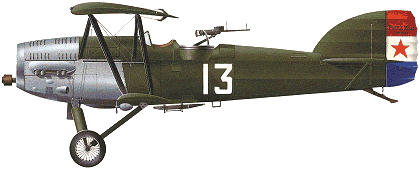| Slawomir Bialkowski, e-mail, 09.04.2025 13:48 In Poland.
The Polish Air Force purchased a total of 45 Potez XXVs in France in 1927-1928 (in Poland the Roman numeral spelling was retained, although the Potez company was already using Arabic numerals at that time) in the following versions: A2 (20 copies), B2 (20 copies), C2 (1 copy), special GR (2 copies) and reference aircraft (2 copies). The first aircraft received in France was the Potez XXV GR (according to [15] - designation Potez XXV A2 Oceanique) in the rally version. Designated for the Tokyo rally, it was crashed on 24.05.1926 en route, during a delivery flight to the country. The next ones were transported by sea from Cherbourg to Gdańsk. Deliveries from France were made at the turn of 1927 /1928.
(According to [14] - on 7.12.1926 the first 6 Potez 25.15s arrived in Poland, another 10 Potez 25s were delivered in 1929, 35 other aircraft of this type were to be delivered to Poland, but the files show that only 16 aircraft arrived from France).
In Poland, under license, the Podlasie Aircraft Factory built 125 Potez XXV A2 aircraft for flight in 1927-1929 and another 25 as spare parts. In the Plage & Laśkiewicz Mechanical Works (ZM PI&L) in the years 1928-1932 150 units were built, including 100 in the A2 version and 50 in the B2 version (according to [1], while according to [11] - 50 units in the A2 version and 100 in the B2 version were built). Potez XXV aircraft were also to be manufactured by WWS "Samolot", but in 1926 the order was withdrawn. According to [1] - a total of 275 complete aircraft and 25 in parts were manufactured in the country. In total, the Polish military aviation received 320 (according to [14] - 316) complete Potez XXV aircraft, including 245 in the A2 version, 70 in the B2 version, 2 in the GR version, 1 in the C2 version and 2 standard ones. They were given the type number 42.
In 1928, engineer Jerzy Rudlicki developed a design for the Lublin R-XVII linear aircraft, a development version of the Potez XXV aircraft equipped with a retractable undercarriage in flight.
The Potez XXVs were introduced to units from 1927. They were first received by training squadrons and flight schools, and later by linear squadrons. They were the equipment of the following squadrons: 12. EL, 113. EMN, 211. ENN (several in 1928), 211. EB (temporarily in 1936), Esk. Staff at 1 PL, 31., 32., 34., 35. EL, 41., 42. EL, 51., 54., 55. EL, Porubanek Detachment - the seed of 53. ET, 61., 62., 64., 65. EL, 63. ET. There were several Potez XXVs in 2 PL - one was available to the commander of the III Aeronautical Group, the rest in the aerophoto platoon and pilot school at 2 PL. Several were assigned to flight schools. Individual aircraft were used as available by regiment commanders. One or two were assigned to various units, e.g. KOP Squadron in Sarny, LPW Camps, IBTL Research Section, etc. The Potez XXV enjoyed a good reputation. It had good performance and was correct in flight. Three Polish-made Potez XXVs took part in the Balkan raid on 13-23.05.1928 Warsaw-Bucharest-Belgrade-Sofia-Constantinople-Iasi-Warsaw, while on 2-12.08.1928, three Potezs took part in the Second Flight of the Little Entente and Poland. In 1927, the delivery of 33 Potez XXVs was offered to Romania, but the order was never made.
The following versions were used in the Polish Air Force:
- Potez XXV A2 - basic reconnaissance version,
- Potez XXV B2 - light day bomber, French version,
- Potez XXV A2 GR - long-range rally plane,
- Potez XXV B2 - light day bomber, version developed at Zakłady Mechaniczne Plage & Laśkiewicz (ZM PI&L), differing in construction details and greater bomb load capacity,
- Potez XXV C2 - escort fighter with GR Jupiter engine, French offer for the Polish Air Force. It differed in dimensions and performance. One example was available. Transferred in 1929 from GSL, it was initially in IBTL, and later in 1 and 3 PL. In 1928, PWS provided for the possibility of building a series of 25 Potez XXV A2s with a GR Jupiter engine, but they were made in the traditional version with Lorraine-Dietrich engines,
- Potez XXV M2 - a night fighter aircraft, with an LD 12Eb engine. One copy was equipped with 2 Vickers wz. 09 pilot machine guns and was tested in IBTL in 1932. In 113 EMN, standard A2s were used without bomb armament, with unchanged armament,
- Potez XXV B2-BJ - with a Bristol Jupiter VII engine, engine mount and ring cover from the PZL P-7a fighter. In 1936, the LWS ordered the conversion of 50 aircraft. The prototype first flew in April 1936. In the years 1936-1937, another 46 aircraft were converted. Designed for flight schools, they were first used in the 61st and 62nd line squadrons until the introduction of the PZL-23 "Karaś" aircraft. They were used in flight schools until the outbreak of the war. With a lighter and more powerful engine, the aircraft had better performance and flight characteristics,
- Potez XXV "Ślepak" - a 1933 version designed for training pilots without visibility of ... reply |







